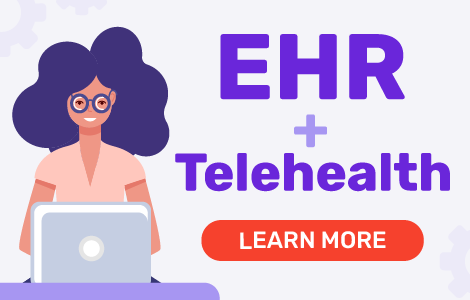
PHQ-9 (or Patient Healthcare Questionnaire 9) is one of the most common tools used to assess Major Depressive Disorder (MDD), a treatable mental illness seen in private practice. The National Institute of Mental Health reported that an estimated 20 million American adults over the age of 18 have experienced at least one depressive episode. That number suggests that at least 8.4% of U.S. adults have presented with depression.
Summary
- The PHQ-9 is a widely used, evidence-based screening tool for identifying and monitoring symptoms of Major Depressive Disorder, based directly on DSM criteria. Download my free PHQ-9 screening tool.
- It is freely accessible, quick to administer and score, and can be completed by clients independently or during a clinician-led session.
- Therapists can use the PHQ-9 at intake, throughout treatment, and at discharge to support diagnosis, tailor treatment plans, and track symptom changes over time. Using an EHR like TheraPlatform can help therapists organize this process.
- While highly reliable and valid, the PHQ-9 should be used alongside clinical interviews and other diagnostic criteria to ensure an accurate and comprehensive assessment.
Streamline your practice with One EHR
- Scheduling
- Flexible notes
- Template library
- Billing & payments
- Insurance claims
- Client portal
- Telehealth
- E-fax

With this high prevalence of therapists seeing clients who present with symptoms of depression, it becomes important in treating clients to have knowledge of screening tools for depression.
While several other assessments and screening tools for depression exist, the PHQ-9 is a reliable and valid screening tool that is freely and easily available to therapists. It is a simple and brief tool for clients to use. When therapists use the PHQ-9 in treatment, the tool can help the clinician and client assess for symptoms and severity consistent with a depression diagnosis, develop an appropriate and individualized treatment plan, and evaluate progress in treatment.
What is the PHQ-9?
The PHQ-9 is a self-report screening tool that therapists and clients can use to help diagnose and treat people with Major Depressive Disorder. Providers can also use the PHQ-9 to help support an initial diagnosis as well during the course of treatment to continue to monitor the severity of symptoms and progress in treatment.
The PHQ-9 consists of nine questions based on the criteria listed in the Diagnostic and Statistical Manual of Mental Disorders (DSM). Clients can independently and easily answer the questions on the tool or the therapist can conduct an interview-type question-and-answer session of the PHQ-9. Each question addresses a symptom of Major Depressive Disorder identified in the DSM. The respondent answers each question on a four-point Likert scale as to the frequency of experiencing the various symptoms over the past two weeks. It should take approximately two to five minutes to complete the screening tool and approximately three to five minutes for the clinician to score it.
Providers can freely access the PHQ-9 by going to the website phqscreeners.com. Users do not need to seek permission or pay to use, administer, reproduce, translate, or distribute the PHQ-9. Additionally, various electronic practice management systems and online telehealth therapy platforms make the PHQ-9 readily available for clinicians to use.
Why use the PHQ-9?
The PHQ-9 can help the treatment provider and client develop a diagnosis, create strong and individualized treatment goals and interventions, and monitor for progress in treatment. If administered at intake, the therapist can use the information gathered from the PHQ-9 toward assessing a diagnosis of Major Depressive Disorder. The therapist can use the outcome of the PHQ-9 in combination with clinical information and history gathered during the assessment interview process to identify or rule out a diagnosis of Major Depressive Disorder. It is important that the therapist also considers clinical information gathered during the assessment interview rather than assign a diagnosis based solely on the score of the PHQ-9.
Other important information needed to meet the diagnostic criteria of the DSM include:
- Do the symptoms cause clinically significant distress or impairment (social, occupational, or other)?
- The episode is not related to the effects of a substance or medical condition
- The episode is not better explained by another mental illness
- There is no history of a manic or hypomanic episode
When the therapist administers the PHQ-9 at intake, the outcome gives the clinician and client a clinical picture of the severity of the depression-related symptoms. The clinician can then use this information to assist with developing and designing a more individualized treatment plan for the client.
Administering the PHQ-9 during the course of treatment can provide the therapist and client with information regarding changes in symptom severity. This information can help to assess progress in treatment. The clinician can also use the client’s answers on the PHQ-9 to guide a clinical discussion on the progress in treatment and to address any need for changes in interventions or a change in the frequency of sessions. For example, if the PHQ-9 administered during treatment indicates an improvement of symptoms, it may be appropriate for the therapist and client to discuss stepping down in the frequency of sessions or continuing with the current treatment model for a period of time. If the score indicates an increase in severity of symptoms, then it might warrant a discussion of what to do differently in treatment.
Practice Management + EHR + Telehealth
Manage more in less time in your practice with TheraPlatform
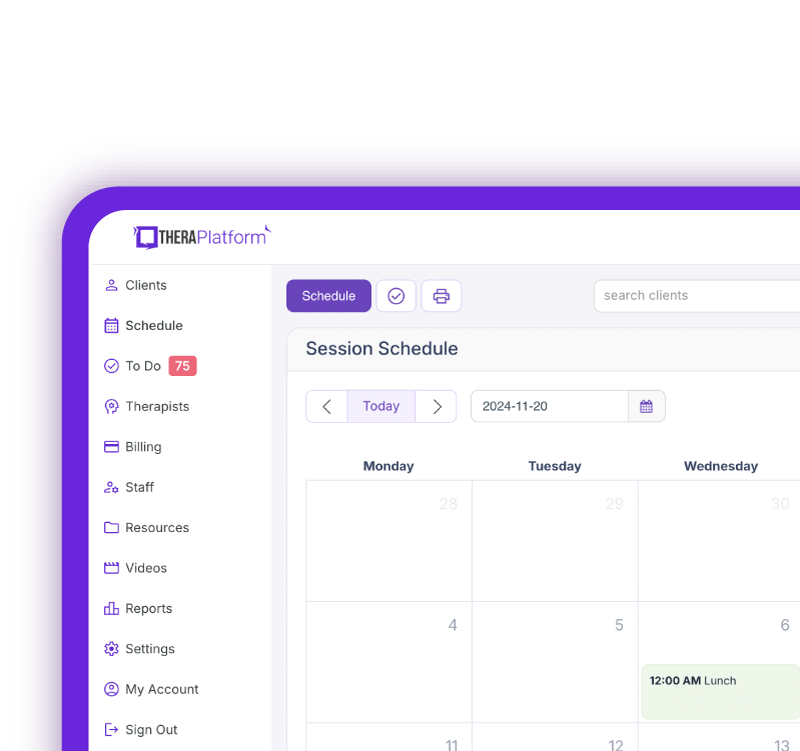
How to administer the PHQ-9
On the PHQ-9, clients answer nine questions on a Likert scale regarding the severity of nine diagnostic criteria identified in the DSM for Major Depressive Disorder over a two-week period of time. Clients can independently answer the questions prior to the session, during the session, or upon completion of the treatment session. Some clinicians may prefer to administer the tool as part of the treatment session in an interview format. If the therapist administers the PHQ-9 in an interview format, the clinician needs to adhere to the question-and-answer format and not allow for discussion of the questions or responses during the administration time.
Following the completion of the PHQ-9, the treatment session can allow for further discussion of responses, symptoms, and treatment planning based on the answers and overall score. Treatment providers may want to consider administering the tool upon intake, at regular intervals throughout treatment, and again at discharge.
Scoring and interpretation the PHQ-9
The PHQ-9 may be completed on paper or by an electronic version.
Clients rate the severity of the listed symptoms over the past 2 weeks according to the answers:
- 0=Not at all
- 1=Several days
- 2=More than half the days
- 3=Nearly every day
The symptoms addressed for measurement in the PHQ-9 include:
- Little interest or pleasure in doing things
- Feeling down, depressed, or hopeless
- Trouble falling asleep or staying asleep, or sleeping too much
- Feeling tired or having little energy
- Poor appetite or overeating
- Feeling bad about yourself; feelings of failure; or having let yourself of your family down
- Trouble concentrating, such as reading the newspaper or watching TV
- Moving or speaking so slowly that other people have noticed. Conversely, being so fidgety or restless that you are moving more than usual
- Thoughts that you would be better off dead, or hurting yourself
A final section asks the respondent “If you checked off any problems, how difficult have these problems made it for you to do your work, take care of things at home, or get along with other people?”
The respondent can then answer according to the following choices:
- Not difficult at all (score of 0)
- Somewhat difficult (score of 1)
- Very difficult (score of 2)
- Extremely difficult (score of 3)
Upon the client completing the tool, the clinician totals up the scores to the Likert scale answers.
The total score suggests the severity of depression:
- 1-4 suggests minimal depression
- 5-9 suggests mild depression
- 10-14 suggests moderate depression
- 15-19 suggests moderately severe depression
- A score of 20-27 suggests severe depression
The PHQ-9 is a brief self-administered tool with high reliability and validity that providers and clients can easily use to guide treatment for depression. It is easily administered, scored, and interpreted and can help clinicians towards diagnosis, treatment planning, and assessment for progress in treatment.
Free Resources for Therapists
Click below and help yourself to peer-created resources:

Improving mental health assessment notes with EHR software
EHR software and practice management tools, such as TheraPlatform, offer numerous advantages in creating accurate, efficient, and organized notes.
Top 7 benefits of using EHR for notes management
Manually writing and storing notes can be cumbersome for many therapists. That process can be further exacerbated by simple document requests that include locating, faxing or scanning documents.
Features like customizable templates, secure storage, easy sharing, duplication, electronic signatures, and efax integration, streamline the note process, optimizing therapy documentation and workflows.
- Consistent notes with template library: EHRs equipped with a library of note templates enable therapists to create standardized and concise notes quickly. This feature ensures consistency across notes, making it easier to review client progress. Additionally, EHRs provide centralized storage and management of notes, enhancing accessibility and organization.
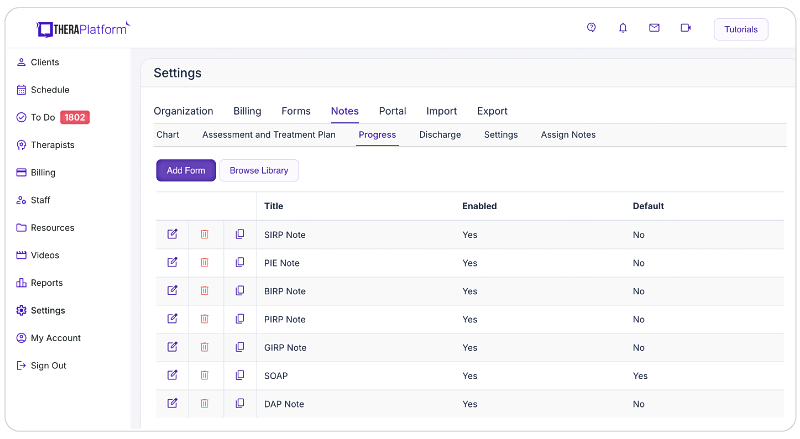
Screenshot of TheraPlatform’s built-in therapy note template library. Notes are one of dozens of types of templates that can be used as is or modified to meet the needs of a therapist in private practice
- Customizable notes: Not all EHRs offer customizable note templates tailored to therapists' unique needs. However, with a robust and user-friendly note template builder, therapists can customize note templates to align with their preferred note-taking style. This flexibility allows for efficient data entry, whether therapists prefer separating sections or using a single note field or checkboxes for mental status or techniques.

- HIPAA-compliant note storage: EHRs prioritize data security by implementing bank-level encryption to safeguard notes and other client information. TheraPlatform, for instance, ensures HIPAA compliance by offering signed, legally-binding Business Associate Agreements to protect Protected Health Information (PHI) between compliant entities.
- Seamless note sharing with clients: Clients may request access to their notes to better understand their treatment or keep them for record-keeping purposes. Using an EHR, therapists can securely share notes with clients, saving time compared to paper-based practices. TheraPlatform, a HIPAA-compliant EHR for therapists, facilitates secure note sharing with clients.

- Duplicate notes: In cases where the data remains the same across multiple sessions, duplicating notes can save time. This feature is particularly useful when clients exhibit repetitive behaviors or show minimal progress, allowing therapists to refer back to previous notes for accurate documentation.
- Client signatures made easy: EHRs streamline the process of requesting client signatures. TheraPlatform's Pro and Pro Plus plans enable therapists to request electronic signatures directly on notes. Clients can conveniently download and print the documents requiring their signatures.
- Easier faxing: TheraPlatform offers efax integration as an add-on feature, eliminating the need for toggling between multiple services. This integrated solution allows therapists to send and receive documents, including notes, via fax directly from TheraPlatform. Additionally, received faxes can be easily filed under the respective client's charts.
Additional tools and outcome measures to help with data collection and progress monitoring
Therapists can also take advantage of EHRs (such as TheraPlatform) that offer integrations with Wiley treatment planners to ensure consistent data collection on progress from session to session. The best part about partnering with a modern EHR is the time you save on formulating the actual notes and scoring.
What is Wiley Treatment Planner?
Wiley Treatment Planner is a widely used clinical resource designed to help mental health professionals and other therapists efficiently create treatment plans for their clients. In addition to treatment plans, the company also provides prewritten therapy notes for some diagnostic codes. It is part of the "PracticePlanners" series published by Wiley.
Features of Wiley Treatment Planner includes:
- Prewritten, evidence-based treatment goals, objectives, and interventions
- Treatment planners tailored to specific populations and problems, including adults, children, adolescents, couples, families, addictions, and more
- Alignment with the diagnostic criteria from the DSM-5 and ICD-10
- Prewritten therapy notes
Is there an online version of Wiley Treatment Planner and how can I get the Wiley Treatment Planner?
Wiley Treatment Planner company partnered with a select number of EHRs for mental health providers to make treatment planners available online. TheraPlatform’s EHR offers the Wiley Treatment Planner as an add-on for both assessment and treatment plans and therapy notes, such as notes. You can edit prewritten notes and add your own with any therapy template on TheraPlatform.
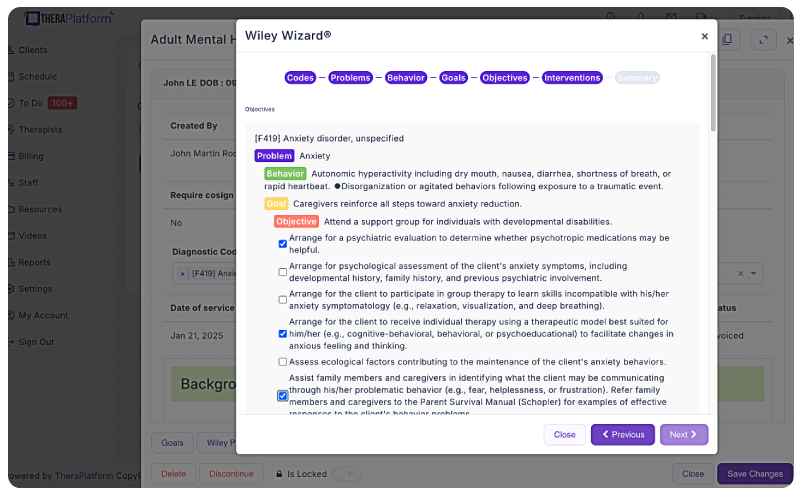
Screenshot of Wiley Treatment Planner integration into TheraPlatform illustrating how areas like problems, behaviors, goals and objectives can be completed with pre-populated, research-based statements.
Save time with automatically scored outcome measures
Mental health therapists can use outcome measures to document progress, track a variety of key clinical indicators, helping providers make data-driven decisions, improve communication with clients, and improve client outcomes. Additionally, outcome measures help therapists adhere to compliance requirements and provide documentation needed to support reimbursement.
Watch this video to learn about how to autoscore outcome measures
→ Sign up for a Free Frial
While outcome measures clearly provide benefits to both clients and therapists, they can be time-consuming, especially if clinicians score responses manually.
However, many aspects of outcome measures can be automated through an EHR like TheraPlatform:
- Sending measurements: Common assessments such as the PHQ-9 or GAD-7 can be automatically sent to clients and stored in their records or they can be scheduled on regular intervals.
- Auto scoring: TheraPlatfrom automatically scores and sums totals for common outcome measures.
- Report building and analysis: Results can be analyzed over time, with visual charts showing progress on rates of severity and session-to-session progress.
By regularly using these measures, therapists can gain valuable insights, tailor interventions, and improve client outcomes while demonstrating the effectiveness of their care without manual entry.
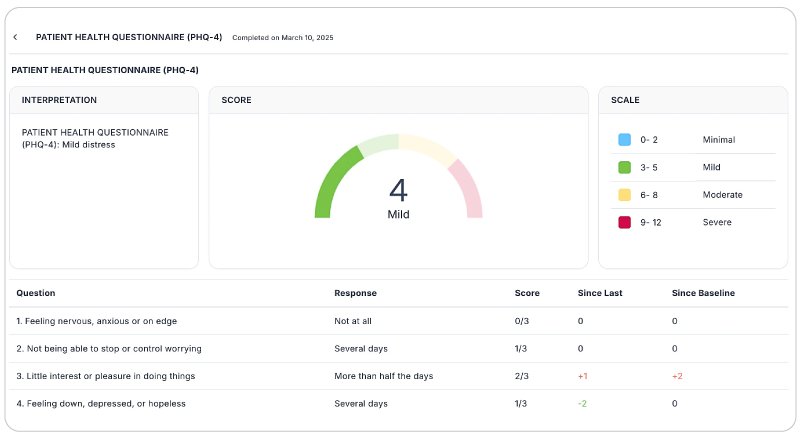
By leveraging the capabilities of EHR software like TheraPlatform, therapists can enhance the accuracy, efficiency, and accessibility of their notes, allowing them more time to enhance client care.
Streamline your practice with One EHR
- Scheduling
- Flexible notes
- Template library
- Billing & payments
- Insurance claims
- Client portal
- Telehealth
- E-fax

Resources
Theraplatform is an all-in-one EHR, practice management and teletherapy solution with AI-powered note taking features that allows you to focus more on patient care. With a 30-day free trial, you have the opportunity to experience Theraplatform for yourself with no credit card required. Cancel anytime. They also support different industries including mental and behavioral health therapists in group practices and solo practices.
More resources
- Therapy resources and worksheets
- Therapy private practice courses
- Ultimate teletherapy ebook
- The Ultimate Insurance Billing Guide for Therapists
- The Ultimate Guide to Starting a Private Therapy Practice
- Mental health credentialing
- Insurance billing 101
- Practice management tools
- Behavioral Health tools
Free video classes
- Free on-demand insurance billing for therapist course
- Free mini video lessons to enhance your private practice
- 9 Admin tasks to automate in your private practice
References
American Psychiatric Association. “Diagnostic and Statistical Manual of Mental Disorders: DSM-5. 5th ed”. 2013.
Kroenke, K., Spitzer, R.L., Williams, J. B. “The PHQ-9: “Validity of a Brief Depression Severity Measure”. J Gen Intern Med. September 2001; 16(9): 606-613. Accessed June 10, 2022.
MIRECC. “PHQ Assessment Resources”. June 10, 2022.
National Institute of Mental Health. “Major Depression: Statistics.” Accessed Jun 10, 2022.



